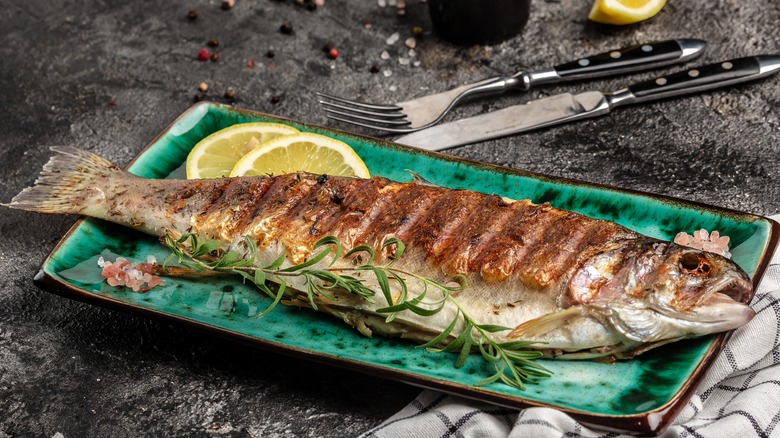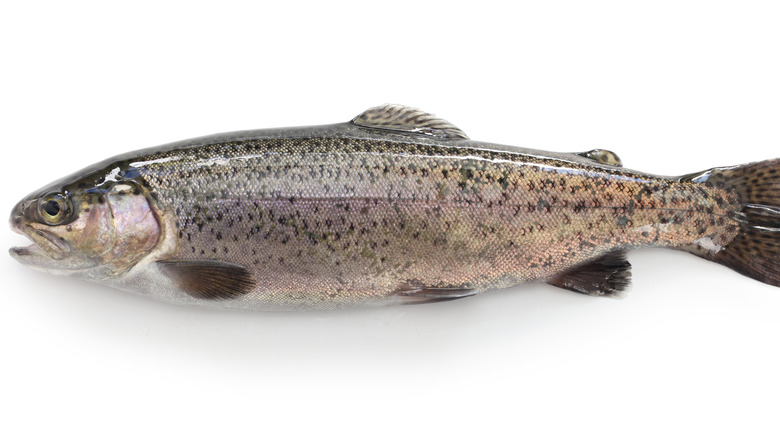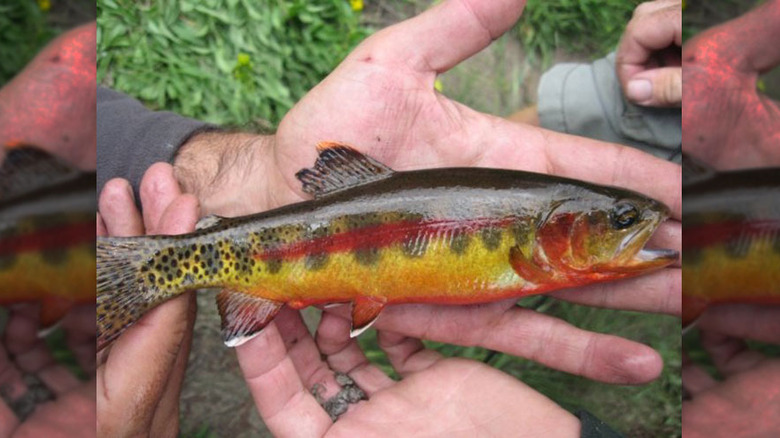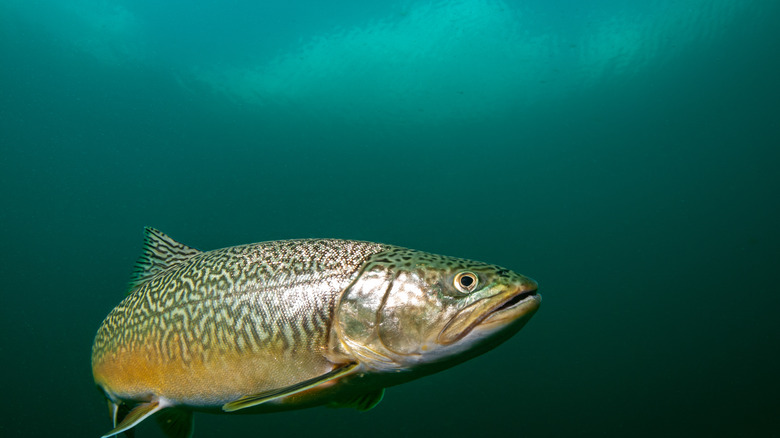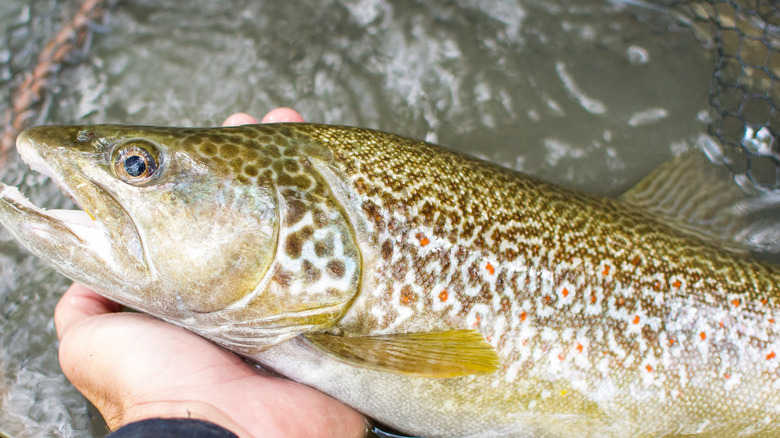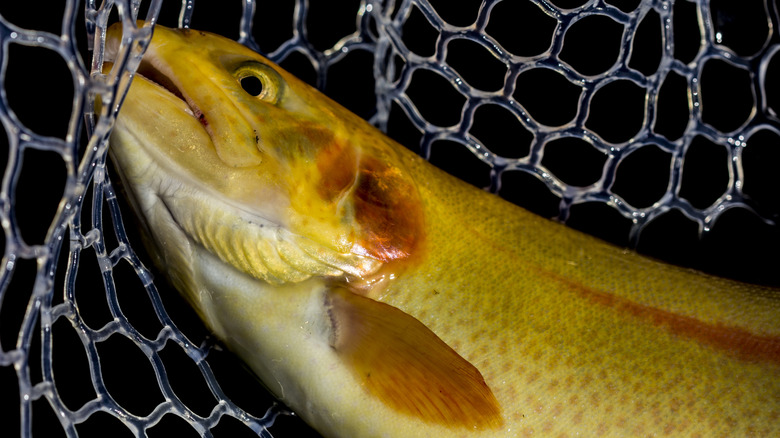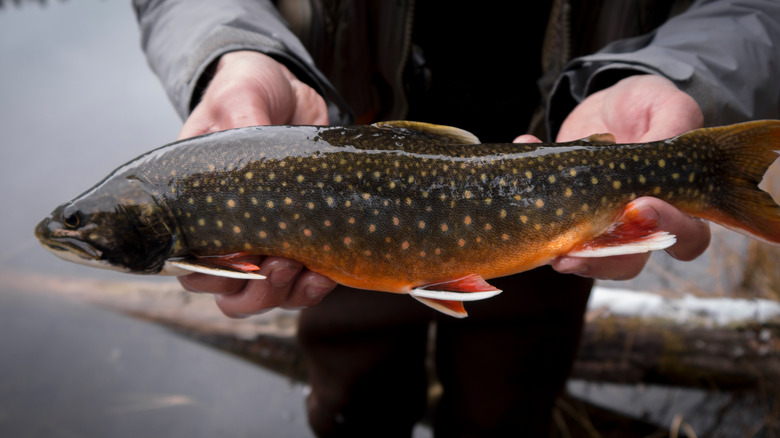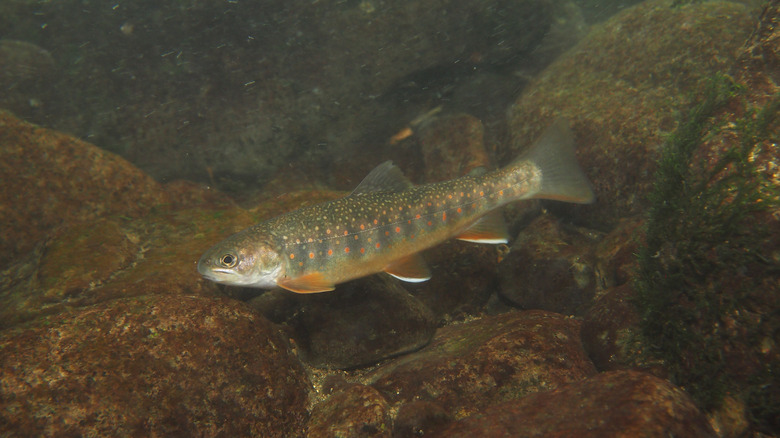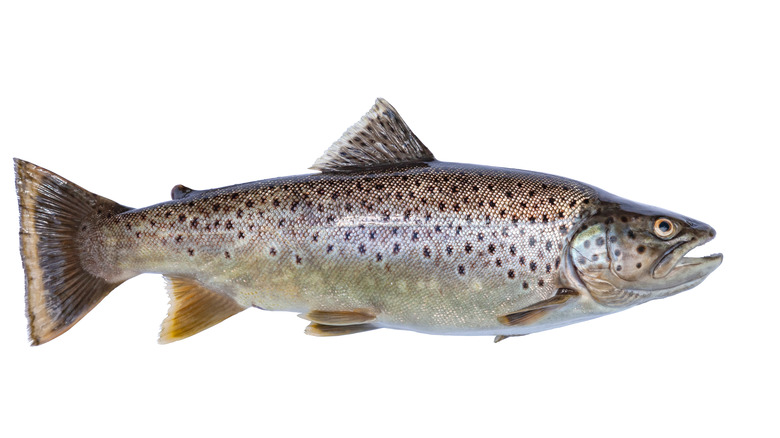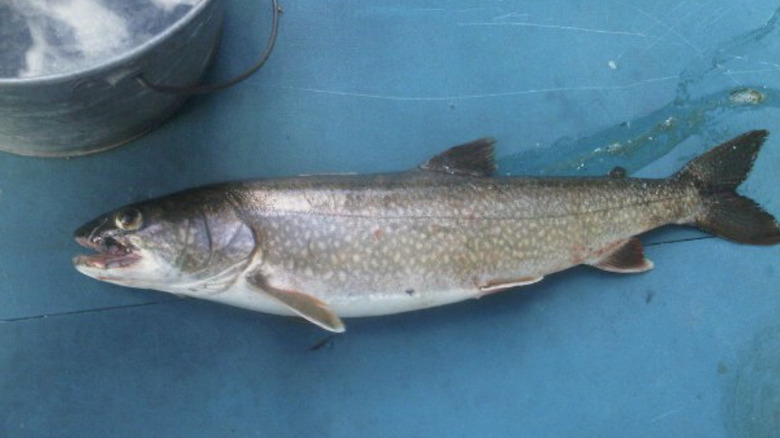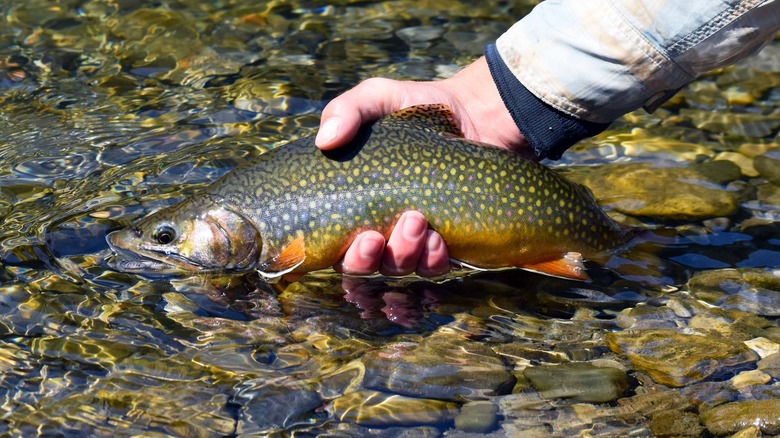10 Types Of Trout And How To Cook Them
Ordering trout at a restaurant is a pretty straightforward choice to make. Once you choose between fried, broiled, grilled, and smoked, it's all pretty much the same, right? Trout is sweet, delicate, and melt-in-the-mouth delicious when drenched in hot sauce.
But there's a lot more to trout than meets the eye. Per SFGate, trout are full of omega-3s and contain a high concentration of B vitamins. There are many different varieties of trout as well. When you consider the myriad of trout species available worldwide, things can get from simple to confusing pretty rapidly.
Trout doesn't come cheap. You need to familiarize yourself with the different types of trout and their unique characteristics so you know what to get on your next trip to the seafood market. This article will discuss the 14 types of trout with assorted tips on eating each fish. After reading this, you'll be prepared to cook the perfect fish feast.
Rainbow trout
If a beautiful palette of colors pops in your head upon hearing the name rainbow trout, surprise, surprise; that's exactly what a rainbow trout looks like. Its body displays a brilliant show of multi-hued coloration featuring silvery-white shades topped with aesthetic notes of blue, yellow, and green (via National Geographic). To top it all off, a gorgeous pink-red stripe runs horizontally from the gills to the tale, per the National Wildlife Federation.
Rainbow trout aren't just pretty to look at: They also taste incredible. The trout's flesh offers a nut-like yet delicate flavor, almost like a salmon. However, AZ Animals says that it lacks the robust and rich flavor of salmon. Nevertheless, you can prepare these beauties in multiple ways, the most common being smoking.
You can also use rainbow trout in this quick dinner recipe for pecan-crusted trout by Jennine Rye of The Marshside Pantry. Top it off with a lemon cream sauce for an enhanced citrusy flavor.
Due to its aesthetic beauty and unparalleled flavor, the National Park Service notes that rainbow trout is one of the most sought-after species for fishing.
California golden trout
Bright and magnificent, the golden trout sports a reddish gold-hued body with brilliant orange streaks and blue-grey spots. The species is native to Sierra Nevada, California. Alberta notes that the colors get even darker during the species' spawning period. California golden trout should be distinguished from a similarly-named trout species, golden rainbow trout.
Per the California Department of Fish and Wildlife, golden trout aren't protected under the Endangered Species Act due to the large-scale conservation measures adopted to help the fish. However, the species is still listed as threatened because of the negative impacts of non-native trout and livestock grazing.
Golden trout is generally rich and full-flavored with a firm, succulent texture and is best paired with light sauces. The meat is incredibly creamy. Don't expect to find this wild trout in your local supermarkets, though.
While most people prefer stuffing and baking a golden trout, there can be plenty of other ways to cook it, including pan-frying, poaching, steaming, broiling and grilling. Just keep the heat low to preserve the natural flavors. Susan Olayinka, the recipe developer for The Flexible Fridge, swears by this crispy fried trout recipe.
Tiger trout
Keeping true to its name, tiger trout has a greyish-brown body that exhibits distinctive wavy patterns like an actual tiger (via Arizona Game & Fish). According to the Oregon Department of Fish and Wildlife, this unique species is a cross between brook and brown trout.
Take Me Fishing notes that tiger trout are generally hostile and feed towards the surface, making them easy to catch. They are almost impossible to find in the wild and are typically bred in private hatcheries in a few states. Since more states are getting on the bandwagon, you can find tiger trout pretty much everywhere now, from Pennsylvania and Idaho to Colorado, Washington, and even the water bodies of Georgia.
Taste-wise, tiger trout is packed with flavors similar to its parent species. The meat is equally delicate and sweet, perhaps a bit firmer and flaky in comparison.
When it comes to cooking them, tiger trout are traditionally prepared with the skin on. Per Cast and Spear, the best way to enjoy a tiger trout is simply cooking it over a fire (after cleaning it, of course). Unlike many other types of fish, tiger trout skin doesn't contain large scales, so you don't necessarily have to scale it. Pan-frying a seasoned flour-coated tiger trout is also a good option.
Marble trout
Native to Southern Europe, marble trout aren't as hard as the name might suggest. The name is actually inspired by the beautiful marble pattern on the trout's body. Lustrik notes that the appearance of marble trout varies considerably. You may also encounter a marble trout with red spots.
Marble trout primarily reside in the Slovenian river system, mainly in the Soca river region. Rivers like Adige, Po, Rižana, Neretva, and tributaries falling into the Adriatic Sea are also home to these magnificent creatures (via Balkan Trout Restoration Group).
Contrary to the earthy-toned outer skin, marble trout's flesh is a beautiful pink and moderately tender. As per Meeting Mountains, since marble trout is considered an endangered species, it's pretty expensive. In fact, this turquoise beauty is so delicate that it can only be handled by the hands of a few top local chefs.
Given the rich flavor profile, marble trout can be served as carpaccios, sizzling meunières, or marinated with light to medium spices. Finish off the dish with classic parsley and lemon butter sauce. You can also take inspiration from the recipes of the world-renowned Slovenian chef Ana Roš (via Saveur).
Palomino trout
Native to Pennsylvania, the palomino trout is the product of a purposeful cross between a single golden trout found in a West Virginia hatchery and a regular rainbow trout (via Tackle Village). According to Andersons Fishcamps, the yellow tint has also earned palomino trout names like "swimming bananas" and the "lightning trout”. The bright yellow hue means they can stick out like a sore thumb in even the murkiest water.
Panfish Nation notes that palomino trout are hefty and can grow up to 15 to 19 inches. What's more, they put up a good fight, which makes them incredibly hard to catch. Since their population is far smaller than that of rainbow trout, palomino trout are considered a rare breed
If you are fortunate enough to get your hands on these golden beauties, you can prepare them in multiple ways, from grilling and steaming to roasting, frying, and braising. Taste-wise, the flavor is pretty similar to that of a rainbow trout — mildly flavored with a flaky texture that melts in your mouth. The flesh of a palomino trout is more pink-toned, however. Try the Moroccan-spiced smoked trout salad recipe if you are not in the mood for the traditional trout broil.
Splake trout
Primarily raised in hatcheries and then stocked in bodies of water for sport fishing, splake trout are a cross between a male brook trout and a female lake trout (via Maine Department of Fisheries). Splake trout, which also goes by the name "wendigo", is plentiful in the cold water bodies of the US and Canada, per Fish Masters.
Fish Masters also notes that the best way to distinguish a splake trout from its parent species, brook, is by looking at its triangular-shaped tail. According to Fisk Keeping Folks, splake trout typically reach an average length of 8 to 18 inches. However, bigger ones have been spotted. ETV News reported in 2018 that Buckley Jolley caught a whopping 30.5-inch spale at the Joe's Valley Reservoir.
The good news is that the splakes have successfully inherited a unique blend of taste from both of their parents' species — sweet and tender. From frying and grilling to baking and broiling, splakes don't disappoint. Perhaps the best way to fully enjoy a splake trout is beer battering a splake trout with sides splashed with some tartar sauce. Folks who prefer a smoky flavor can try this delicious smoky potato and trout celery salad.
Dolly Varden trout
Beautiful, massive, and flavorful, the Dolly Varden trout is a must-have trout variety. According to Trout Unlimited, this species is a bull trout lookalike and Dolly Vardens and bull trout were considered a single species until 1978. In fact, the two species look so similar that they are often called by a single name — dollies. The only difference, as Fishing with Rod notes, is that Dolly Varden trout have a shorter upper jaw.
Per the Alaska Department of Fish and Game, the species largely populates the Alaskan Peninsula, but their range also stretches to Mackenzie River, Canada. Once cooked, the Dolly Varden turns golden brown and crispy from the outside, while the meat appears pink and tender. Dolly Vardens typically tend to be more oily and less fishy-tasting than bull, brown, and even brook trout. Hurl them onto a grill, saute in a pan, or bake on a brochette; there's literally nothing you can't do with Dolly Vardens.
Brown trout
Make room for the king of trout, the brown trout, also known as the "German" brown. The freshwater bodies across Atlas mountains in North Africa up to Iceland are the oldest homes to brown trout. Per the National Park Service, these creatures were later introduced to North America, the state of Virginia particularly.
According to Fish and Game, harvesting brown trout is considered a common freshwater sportfish in New Zealand since they are plentiful. In fact, Lake Superior Streams notes an interesting fact that a single female brown trout can lay up to 2000 eggs.
Woodland Trust reports that brown trout are pretty interesting in the sense they can literally see out of all corners of their eyes.
While brown trout taste similar to the rainbow species, the texture is different. Per Mike of High Adventure Videos, brown trout has a meatier, fuller texture. Conversely, rainbow trout are relatively flakier. The bottom line, however, is that both are equally delicate and finger-licking good.
Lake trout
Native to the Canadian freshwaters, lake trout is one of a kind. As per BassOnline, it goes by several other names, including namaycush, lake char, Mackinaw, touladi, grey trout, togue, siscowet, lean, and paperbelly. Phew, that was a lot. Lake trout can grow very large and live for up to two decades.
According to the Maine Department of Fisheries, lake trout can be distinguished from brook trout by its bronze-toned skin dappled with creamy white markings and a forked tail. Taste-wise, lake trout are relatively easy to cook, so feel free to fry, grill, bake or smoke these fellas. However, turn down the flame and don't go overboard with the cooking time. You don't want to burn the fish and accidentally wipe off the omega-3 fatty acids sitting inside the Lake trout's flesh (via Journal of Great Lakes Research).
Since lake trout have a mild, gentle flavor, it's best to pair them up with rich sauces.
Brook trout
Anglers love them, chefs love them, and we love them. Thanks to their unique flavor and delicate texture, brook trout are a crowd-pleaser. The meat has just the right amount of juiciness and sweetness. We also love the brookies for the splake species, a cross between a male brook trout and a female lake trout (via WildernessNorth).
According to the US Fish and Wildlife Service, brook trout rule eastern North America, stretching from the Eastern Great Lakes, the Atlantic Ocean, and all the way to the Appalachian Mountains. As the Chesapeake Bay Program notes, brook trout are pretty things. Their green backs are decorated with worm-like marks, and the sides are heavily marked with yellow spots and red/pink spots with blue halos.
Brook trout are best served with their skin on, which turns a toasty golden brown color once broiled. The star of the show, however, is the brookies' delicate flesh. From pan-frying and braising to grilling and roasting, brook trout can be cooked in countless ways. Perhaps the best way to fully appreciate a brook trout is cooked meunière style, dragged in flour and sauteed in butter, and finally drizzled generously with a lemon butter sauce.
